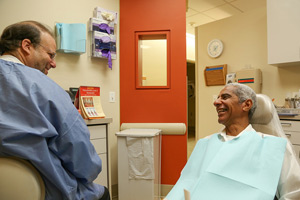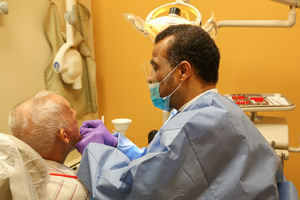Access to and Utilization of Dental Services

National data indicate that a greater number of older adults are using dental services than ever before, and that they have made the greatest proportional increase in utilization of dental services than any other age cohort. According to data from the 2000 Medical Expenditure Survey (MEPS), more than 14 million non-institutionalized older adults visited a dental provider in the previous year, reporting an average of 2.8 visits per year. Despite the dramatic increases in dental services utilization seen over the past five decades, less than 56% of the elderly report using dental services at least once in the past year, and disparities in use of professional dental care persist. Predictors of dental care utilization in adults over the age of 65 include race and ethnicity, dentate status, education, age, income and dental insurance.
Race and Ethnicity
While whites are more likely to receive oral care services than minority populations at all ages, among dentate older adults, only 31.7% of African-Americans reported a dental visit in the past year compared to 65.6% of whites. Although Hispanics and Native Americans have not been adequately represented in national studies, of all racial and ethnic groups, they are least likely to utilize dental services.
Dentate Status
Dentate status is a predictor of dental services utilization among all races in the United States. Utilization rates are markedly lower among edentulous individuals - 72.5% of dentate adults reported using dental services in the past year- compared with 24% of edentulous adults. The presence of teeth may be intimately associated with perceived need for dental services; individuals who do not have teeth believe that they do not need to seek dental services, regardless of the quality and functional adequacy of dental prostheses or impact on quality of life.
Dentate adults are more likely to use dental services than edentulous adults
Edentulous adults are at risk for oral cancer, and weight loss or gain can result in ill-fitting prostheses, which in turn may impact ability to eat and communicate, and quality of life. If the relationship between dentate status and utilization does hold into the future, as an increasing proportion of older adults retain their natural teeth, it is reasonable to expect that demand and utilization of dental services will increase.
Education
While there have been some attempts to use dentate status as a proxy measure for socio-economic status, the relationship is not entirely clear. When assessing national population samples, education is a significant predictor of dental services utilization. Not only do a larger proportion of college graduates report making a dental visit, but they have more frequent contact with dental providers and are more likely to have dental insurance than older adults with some or no schooling. When examined more closely however, education does not play a major role in utilization among all races. While more than eight years of schooling is significantly associated with utilization of services among whites, it is not a significant predictor of utilization among African-Americans, Hispanics or Native Americans.
Age
Data that examine utilization of dental services by age suggest that utilization declines dramatically in the elderly. While 68% of middle-aged adults reported a dental visit in the previous year, only 53.5% of adults over 65 reported a dental visit in the previous year, and more than 28% of the elderly had not visited a dentist in the past ten years. Similarly, among the elderly, those aged 75 and older were significantly less likely to have made a dental visit than those aged 55-64. Although there are no studies that examine the reasons for these differences, cohort effects shaped in part by historical and social events have been suggested.

Challenges to utilization of dental services
Fixed income, lack of private insurance, medical, functional and cognitive co-morbidities, transportation, difficulty navigating the health care system, cultural barriers, and an untrained workforce – are all factors that make utilization of dental services difficult for older adults.
Income
Although older adults’ medical and dental care needs are greater than ever before, for many seniors the ability to finance care declines with age. Older adults with lower incomes are less likely to use dental services. Similarly, high income seniors report more frequent utilization of dental services, and are also more likely to have private dental insurance.
Insurance
Numerous studies indicate that at all ages, those with private dental insurance utilize dental services more than those who do not have dental insurance. Not only is dental insurance associated with utilization of dental services, but so too is private health insurance, suggesting that health insurance, regardless of whether it is dental, private or public, may act as an enabler of utilization, because adults with some coverage may be able to use some of the health savings towards dental care.

